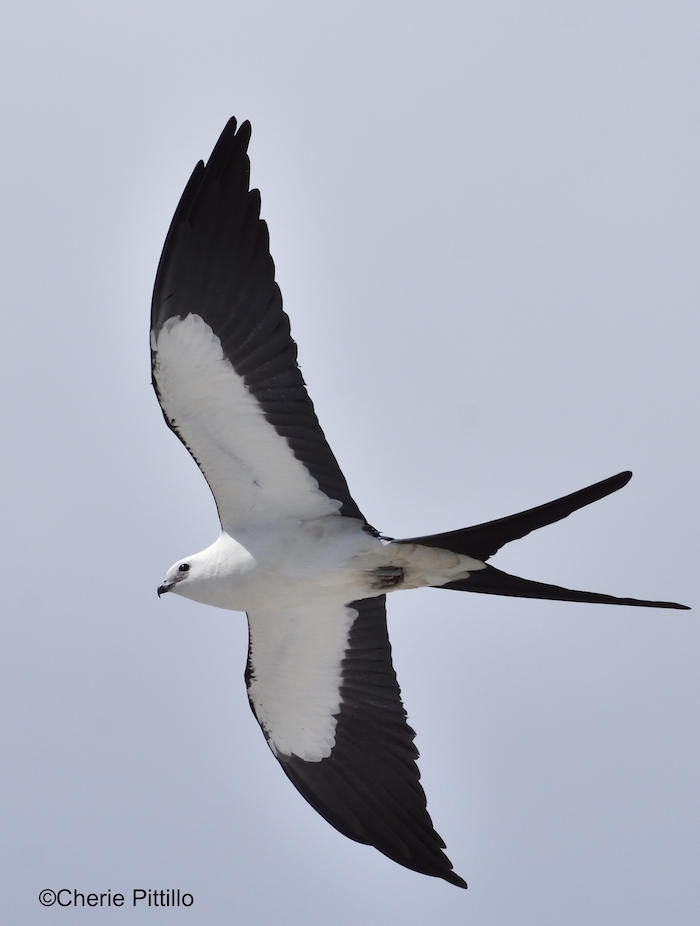
SWALLOW-TAILED KITE, Elanoides forficatus, Milano Tijereta (Spanish)
Magnificent. Graceful. Beautiful.
These words describe the sailing-through-the-sky flight of the Swallow-tailed Kite, with a four foot wingspan and a deeply forked tail resembling open scissors. Perhaps the simple coloration of a blackish back and wing linings, white head, and soft whiteness underneath lends to its beauty.


Even its small rounded head, dark eyes, and small beak don’t look like a typical bird of prey. This kite lacks a brow bone (supraorbital ridge) above the eyes for a dove-like look which contrasts with the so-called stern looks of many hawks and eagles. Also, its feet and talons appear tiny for a raptor.


This masterful flier seems to stay aloft without flapping as if on a leisurely stroll through the sky. Its secret is two fold: the ratio of long narrow wings to short wide wings result in lower drag with a higher lift (high aspect ratio). And the forked tail, whether partially open or closed, acts as a rudder to steer the slim, sleek bird as it sails.


Two look-alike subspecies exist with the northern one breeding primarily in Florida to winter in South America. As a transient species of the Yucatan, this migrant can be observed here from July to September and then again on its return from February to March.
Nearby in Guatemala lives the southern subspecies which breeds from S. Mexico (less the Yucatan Peninsula) through south-central South America. Both species occur in subtropical and tropical forests and/or swamps, marshes, and coasts.
In Costa Rica and Panama the southern subspecies lifted my spirits to want to soar like them. What great freedom that effortless flight represents! I’ve happily observed and photographed the northern subspecies in flight mainly in Florida yet rarely saw them in the Yucatan.
I never found a roost or a breeding colony, for unlike other raptors, they are social. They also tend to gather in large roosts before migrating. For three winters I’d spot maybe one or two kites in flight, but never saw them perch. Well, until this past winter. Finally one landed precariously about a hundred feet from me in a tree top. After gaining its balance, it perched and preened. Here are my only photos of that behavior. ( I preened to after getting an image or two!)



Depending on the scientific study, the time of year, and location, the Swallow-tailed Kite feeds mainly on insects or mainly anole lizards or mainly frogs or something else. At least research agrees the kite seizes its food with its small feet and relatively tiny talons and dines on its capture all while flying. A sort of flycatcher, perhaps? Eating “slow food” on the run while driving, so to speak?


In addition it glides along the treetops, shrubs, and the ground searching for its prey which also includes snakes and birds, especially nestlings. One study notes that more anoles and snakes comprised the diet for the kites’ chicks during morning and evening hours, while birds seemed to supply midmorning to mid-afternoon snacks. The young are also fed insects. Sometimes the kite may bring a paper wasp nest to feed the larvae to its chick.

Not only does this aerial artist cruise low over the canopy, it also skims calm water to drink, well, swallow-like, and to clean its stained belly feathers, probably dirty from holding its food while flying. In Panama a Tropical Kingbird forced this kite cousin to leave as it tried to drink and bathe. By the way, the southern kite may also eat small fruits, another atypical raptor behavior.


Both subspecies parents build the nest, incubate two eggs laid 3-5 days apart, and feed the chicks. However, one raptor behavior the Swallow-tailed Kite shares with eagles is siblicide, especially in the southern kites. Usually the second chick is killed by its sibling within a week. This behavior appears to be uncommon in the northern species but it has been observed. Don’t worry too much, siblicide also occurs in egrets, pelicans, gannets, and boobies, an adaptation for survival of one chick.
And still, the flight is a joy…magnificent, graceful, and beautiful.
TAKE TIME TO ENJOY NATURE TO LET YOUR SPIRIT SOAR!
DISCLAIMER: References do not agree on details about these species:
Sal a Pajarear Yucatan, Birds & Reserves of the Yucatan Peninsula, A Guide to the Birds of Mexico and Northern Central America, Life Histories of North American Birds of Prey, Lives of North American Birds, A Guide to the Birds of Costa Rica, Common Coastal Birds of Florida and the Caribbean, The Birds of Panama
Gerhardt, R. P. , M. A. Vasquez , and D. M. Gerhardt . 1997. Siblicide in Swallow-tailed Kites. Wilson Bulletin 109: 112–120.
- https://www.allaboutbirds.org/guide/Swallow-tailed_Kite/id
- https://academic.oup.com/condor/article/106/1/171/5151888
- https://sora.unm.edu/sites/default/files/journals/condor/v067n03/p0235-p0246.pdf
- http://arcinst.org/attachments/stashed_filesMeyer___Communal_Roosts_of_the_American_Swallow_tailed_Kite_in_Florida.pdf
- https://digitalcommons.georgiasouthern.edu/etd_legacy/216/https://digitalcommons.georgiasouthern.edu/etd_legacy/216/
- https://www.hbw.com/species/swallow-tailed-kite-elanoides-forficatus
- https://www.audubon.org/field-guide/bird/swallow-tailed-kite
- https://myfwc.com/wildlifehabitats/profiles/birds/raptors-and-vultures/swallow-tailed-kite/
- https://myfwc.com/wildlifehabitats/profiles/birds/raptors-and-vultures/swallow-tailed-kite/
- https://birdsna.org/Species-Account/bna/species/swtkit/appearance
Cherie Pittillo, “nature inspired,” photographer and author, explores nature everywhere she goes. She’s identified 56 bird species in her Merida, Yucatan backyard view. Her monthly column features anecdotes about birding in Merida, Yucatan and also wildlife beyond the Yucatan.
Contact: [email protected] All rights reserved, ©Cherie Pittillo
